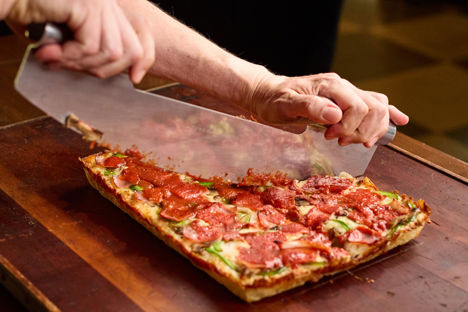
Detroit-style pizza: Motor City secret to America’s favourite slice
Once a well-kept secret, Detroit-style pizza is finally earning the following it deserves. From its reverse layering to its blue steel pans, we look at what sets it apart. Photo: Buddy's Pizza
Detroit-style pizza: Motor City secret to America’s favourite slice
Once a well-kept secret, Detroit-style pizza is finally earning the following it deserves. From its reverse layering to its blue steel pans, we look at what sets it apart. Photo: Buddy's Pizza
Internet searches for Detroit-style pizza in the UK were pretty steady in 2019 and 2020, in that there were hardly any – it wasn’t until early 2021 that interest started to grow steadily, continuing until a spike in February this year which fell, perhaps coincidentally, in the same week that Detroit-style pizza was voted America’s favourite on National Pizza Day. Although it was born in Michigan’s Motor City in the 1940s, for some time the rectangular pie remained something of a secret. But over the last decade that’s certainly changed – today there are pizzerias dedicated to it across America and further afield and in 2021, in perhaps the biggest sign that it had reached the mainstream, Pizza Hut introduced its own version in the US, releasing the recipe after tracking interest for over a year (it quickly sold out, and contributed to Pizza Hut’s best quarterly sales results in a decade).
Our awakening to Detroit pizza in the UK has been understandably slower, but that’s fast changing, with a flurry of new spots where we can grab a slice opening in recent years; there's ria’s and Kin Pizza (both of which opened in 2023), as well as Detroit Pizza London, which began life in Battersea in 2020, moving to Spitalfields in 2021 and opening a second Islington site in late 2023. The latter was created by Ryan O'Flynn, a Canadian chef who spotted a gap in the London market and became fanatical about developing the perfect dough and sauce. His efforts paid off – he quickly impressed Americans in the city, who queued patiently for a slice and in many cases returned with their British friends, a buzz which played no small part in introducing London to Detroit pizza. Saucy, crispy and fluffy, Ryan thinks we Brits have partly been won over by the style's textural similarities to the humble cheese toastie – makes sense to us. Whatever's behind it, it's fair to say Detroit style has proved a hit (they're currently looking to expand to meet demand).
It’s been almost eighty years since Gus and Anna Guerra, the owners of the still-standing Buddy’s Pizzeria, first decided to, the story goes, throw a batch of Sicilian dough into a blue steel pan and bake it with cheese and sauce, but thank goodness they did. Here, we’ve taken a deep dive into Detroit’s cherished deep dish to explore what makes it so special.
The crust
At first glance, Detroit’s pizzas look similar to those from Sicily, in that they are rectangular in shape and lighter and fluffier than other varieties. Their shape comes from the blue steel pans they’re baked in, which were originally used to store automotive parts in the city’s factories. Dough is pressed into the pans and left to proof, sometimes twice, until it’s ready to bake. The pans are also responsible for the pizzas’ crispy, slightly darkened sides – the bottom of the dough has a lightly-fried texture, which comes from its time sizzling in oil rendering from the cheese. Detroit crusts are generally thicker than those of Sicilian pizzas and the texture is less dense and more chewy.
The cheese
Once the dough is ready to bake, the layering can begin. Detroit-style pizzas are reverse layered, and the cheese usually goes on first – the dough is covered in cubes of Wisconsin brick cheese, a semi-hard cow’s milk cheese which originated in the state in the late 1800s (its name is inspired by the bricks that cheese-makers used to press out the moisture from the cheese). The cubes are placed all the way to the edges of the pan, which means that, once melted, they create a crispy, caramelised cheese crust around the edges. Wisconsin brick cheese can be found online, but if you can’t get your hands on it, look for a cheese that browns well – a combination of a mild cheddar and mozzarella would work.
The toppings
You’ll usually find the toppings laid on top of the cheese and underneath the sauce (more on that below), though it’s not always the case. At Buddy’s, pepperoni is put directly on the dough so the oil and flavour from the meat is absorbed into it, before the cheese. Sometimes pepperoni is also dotted on top of the sauce. Common toppings include small cup pepperoni, Italian sausage and peppers and onions, though – as with most types of pizza – there are all sorts of variations.
The sauce
The sauce is one of Detroit-style pizzas’ defining characteristics – it’s usually the last thing to go on, either in distinctive dollops or stripes, the latter of which are nicknamed tire tracks. Go easy, though – Detroit pizzas have less sauce than Chicago varieties. Putting it on as the final step (particularly when it’s striped) is what gives the pizzas their distinctive look and red top nickname. As for the sauce itself, it’s often a classic marinara – our simple, five-ingredient recipe is this way if you’re in need of inspiration.
Hungry for more? To know your Sicilian pies from your New York slices, don't miss our speedy guide to pizza styles.

